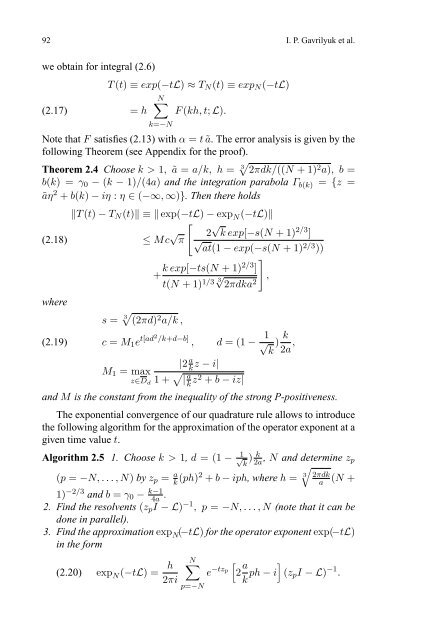H-Matrix approximation for the operator exponential with applications
H-Matrix approximation for the operator exponential with applications
H-Matrix approximation for the operator exponential with applications
You also want an ePaper? Increase the reach of your titles
YUMPU automatically turns print PDFs into web optimized ePapers that Google loves.
92 I. P. Gavrilyuk et al.<br />
we obtain <strong>for</strong> integral (2.6)<br />
T (t) ≡ exp(−tL) ≈ T N (t) ≡ exp N (−tL)<br />
N∑<br />
(2.17)<br />
= h F (kh, t; L).<br />
k=−N<br />
Note that F satisfies (2.13) <strong>with</strong> α = t ã. The error analysis is given by <strong>the</strong><br />
following Theorem (see Appendix <strong>for</strong> <strong>the</strong> proof).<br />
Theorem 2.4 Choose k>1, ã = a/k, h = 3√ 2πdk/((N +1) 2 a), b=<br />
b(k) =γ 0 − (k − 1)/(4a) and <strong>the</strong> integration parabola Γ b(k) = {z =<br />
ãη 2 + b(k) − iη : η ∈ (−∞, ∞)}. Then <strong>the</strong>re holds<br />
‖T (t) − T N (t)‖ ≡‖exp(−tL) − exp N (−tL)‖<br />
(2.18)<br />
≤ Mc √ [<br />
π<br />
2 √ k exp[−s(N +1) 2/3 ]<br />
√<br />
at(1 − exp(−s(N +1) 2/3 ))<br />
]<br />
+ k exp[−ts(N +1)2/3 ]<br />
t(N +1) 1/3 3√ ,<br />
2πdka 2<br />
where<br />
s = 3√ (2πd) 2 a/k ,<br />
(2.19) c = M 1 e t[ad2 /k+d−b] , d =(1− √ 1 ) k<br />
k 2a ,<br />
|2 a k<br />
M 1 = max<br />
z − i|<br />
z∈D d 1+ √ | a k z2 + b − iz|<br />
and M is <strong>the</strong> constant from <strong>the</strong> inequality of <strong>the</strong> strong P-positiveness.<br />
The <strong>exponential</strong> convergence of our quadrature rule allows to introduce<br />
<strong>the</strong> following algorithm <strong>for</strong> <strong>the</strong> <strong>approximation</strong> of <strong>the</strong> <strong>operator</strong> exponent at a<br />
given time value t.<br />
Algorithm 2.5 1. Choose k>1, d =(1− √ 1<br />
k<br />
) k 2a , N and determine z p<br />
√<br />
(p = −N,...,N) by z p = a k (ph)2 + b − iph, where h = 3 2πdk<br />
a (N +<br />
1) −2/3 and b = γ 0 − k−1<br />
4a .<br />
2. Find <strong>the</strong> resolvents (z p I −L) −1 ,p= −N,...,N (note that it can be<br />
done in parallel).<br />
3. Find <strong>the</strong> <strong>approximation</strong> exp N (−tL) <strong>for</strong> <strong>the</strong> <strong>operator</strong> exponent exp(−tL)<br />
in <strong>the</strong> <strong>for</strong>m<br />
(2.20) exp N (−tL) = h<br />
2πi<br />
N∑<br />
p=−N<br />
e −tzp [<br />
2 a k ph − i ]<br />
(z p I −L) −1 .
















